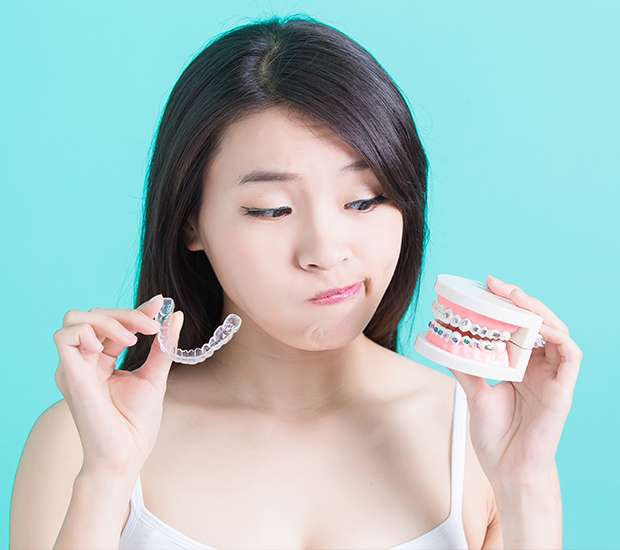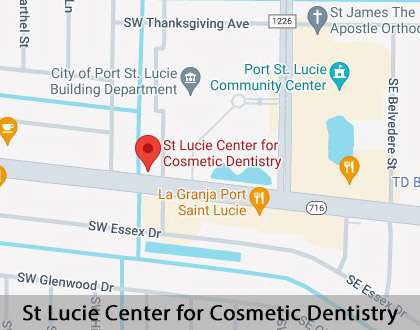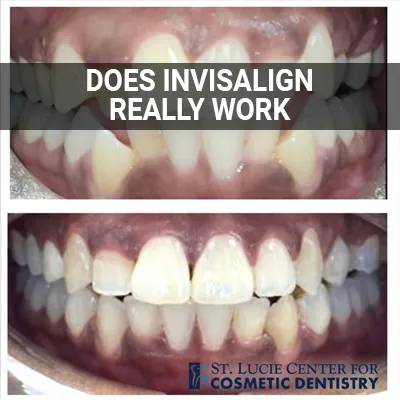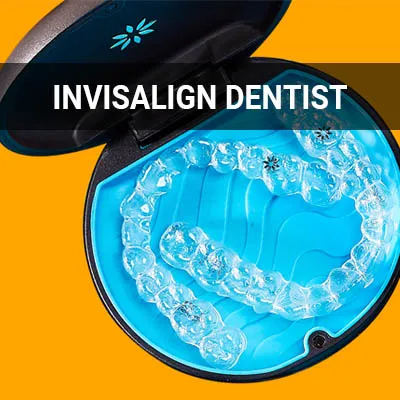Which is Better Invisalign or Braces Port St. Lucie, FL
When deciding whether Invisalign® or braces are better, patients should compare their effectiveness, reversion after treatment, and dietary restrictions. While both orthodontic treatments straighten teeth, Invisalign offers unique benefits due to their discrete appearance and removability. Patients should carefully consider the advantages and disadvantages of both appliances before making a decision.
Orthodontic treatment is available at St Lucie Center for Cosmetic Dentistry in Port St. Lucie and the surrounding area. Our team can help determine whether Invisalign or braces is the right choice for you. Call us today at (772) 242-4124 to learn more about our services or schedule an appointment.
The Difference Between Metal Braces and Invisalign
While metal braces and Invisalign provide the same end result, it is important to understand the differences and similarities between the two.
Metal Braces
While people may connect metal braces to children or teens, they are still an effective form of dental correction for patients of all ages. For many years, metal braces remained the only option to correct crooked and crowded teeth. Braces involve metal brackets glued to the enamel of each tooth. Metal wires are laced between the brackets to help shape and mold teeth over time. The wires placed on the bracket can sometimes be the same color as tooth enamel so they are less noticeable; however, most of them are metal/silver. Patients also have the option to choose multiple colors to add their own unique style to their braces.
Metal braces are irremovable and stay in place for the duration of treatment. They may be a good option for patients who are concerned about losing their aligner trays or do not want to have to change out trays. Treatment time varies by case, but the average for teens tends to be approximately two years. Most patients require a monthly or bi-monthly check-up, so the practitioner can see how teeth shift, adjust wires accordingly, and ensure there are no issues that need to be corrected.
Invisalign
Invisalign offers a clear set of plastic aligners called "trays" customized to fit each patient's mouth. Invisalign uses 3-D imagery of the patient's teeth to configure and customize the trays to ensure the right fit. The smooth plastic used to create the trays remains BPA-free, providing comfortable wearing. They must be checked and replaced throughout the treatment for both teens and adults to align teeth into the proper position.
Invisalign aligners are removed while eating, drinking, and engaging in activities without interference or concerns about oral injury. Invisalign should be worn approximately 21-22 hours a day for 6-18 months, depending on the issue that needs correcting. Follow-up visits take place approximately every 6 to 8 weeks to change trays. Trays will need to be fitted and customized throughout the treatment as they keep the teeth moving at a gradual pace.
“While metal braces and Invisalign provide the same end result, it is important to understand the differences and similarities between the two.”
When Braces Are More Effective
Invisalign and braces can treat many of the same orthodontic issues, including crooked teeth, overbites, underbites, minor gaps, and crowding. Unlike Invisalign, braces are more effective than Invisalign for correcting more complicated problems. While Invisalign is beneficial for aesthetic purposes and simple malocclusions, braces can apply greater force and create major tooth movements.
Consequently, braces can treat rotated teeth, large gaps, intrusion, and extrusion. A prospective follow-up study by the American Journal of Orthodontics and Dentofacial Orthopedics found that rotation had the lowest overall accuracy of all the tooth movements with Invisalign. Patients with prior dental work or short, round, or pegged teeth may also benefit from braces over Invisalign.
“While Invisalign is beneficial for aesthetic purposes and simple malocclusions, braces can apply greater force and create major tooth movements.”
Invisalign’s Effectiveness on Overbites and Underbites
Advancements in Invisalign technology mean that this system can treat a wider range of problems than before. Invisalign is effective in fixing most underbites and overbites. Treatment for these issues may include a combination of tooth and jaw movements. In some cases, patients will need additional appliances added to their clear aligners.
If jaw movement is necessary, we may provide patients with interarch bands that apply pressure to the jaw and encourage its movement. These bands attach to aligners through small hooks on teeth or adding hooks onto the actual aligners. In other cases, an overbite or underbite may be solved simply through straightening teeth. The optimal time to fix an overbite or underbite is when a patient is younger and their jaw is still developing.
“Treatment for these issues may include a combination of tooth and jaw movements.”
Check out what others are saying about our dental services on Yelp: Which is Better Invisalign or Braces in Port St. Lucie, FL
Possibility of Regression After Treatment
Regardless of whether a patient straightens their teeth with Invisalign or braces, teeth have a tendency to shift out of place. Once patients complete their active orthodontic treatment and no longer use their appliance, their teeth will want to move back to their original position. For this reason, patients must wear a retainer.
Retainers are fixed or removable appliances that keep teeth in place after orthodontic treatment. They apply pressure to teeth and provide guidance to keep teeth in their new position. It is a common problem for patients to lose their retainers. We recommend that patients keep their retainers in a protective case when not in use and closely follow our instructions.
“Regardless of whether a patient straightens their teeth with Invisalign or braces, teeth have a tendency to shift out of place.”
Questions Answered on This Page
Q. What are the differences between traditional braces and Invisalign?
Q. What are the dietary restrictions with braces or Invisalign treatment?
Q. When are braces more effective than Invisalign?
Q. How effective is Invisalign in treating overbites and underbites?
Q. Is there a possibility that teeth can regress after orthodontic treatment?
People Also Ask
Q. Am I a good candidate for Invisalign?
Q. Should I choose Invisalign Teen for my child?
Q. What are the aesthetic differences between Invisalign and traditional braces?
Q. How can someone find the right Invisalign Dentist?
Q. Why is it important for parents to understand their child's orthodontic needs?
Dietary Restrictions
When wearing braces, patients must only eat foods that are "braces safe." Gum and hard foods, such as candies or nuts, are typically off-limits to prevent damage to the braces or injury to the teeth. Invisalign patients do not have dietary restrictions as they remove the aligners while eating and drinking. However, we do recommend patients eat healthy, nutritious food to keep their oral cavity clean during orthodontic treatment.
In order to care for both braces and Invisalign trays, we advise patients to practice enhanced oral hygiene habits. With braces, patients should brush their teeth at least twice daily and use a water flosser or floss designed for braces at least once daily. There are various other tools for patients with braces, especially those with more complicated issues. With Invisalign, patients should remove their aligners while brushing and flossing. The aligners themselves should also be thoroughly cleaned during oral hygiene care to keep them clean and free of food particles or debris.
“Invisalign patients do not have dietary restrictions as they remove the aligners while eating and drinking.”
Frequently Asked Questions About Braces Versus Invisalign Teen
Q. How long will I have to wear Invisalign?
A. The length of treatment will vary for each patient and their individual needs. However, the average length of Invisalign treatment is 12 to 18 months. While simple cases will take less time, more complex orthodontic issues will require more extensive treatment.
Q. How much does Invisalign cost?
A. The cost of Invisalign will vary depending on factors, including the patient's treatment needs and insurance plan. Every insurance plan is different. People interested in Invisalign should contact their insurance provider for coverage information before seeking treatment.
Q. Will Invisalign interfere with my lifestyle?
A. Unlike other orthodontic options, Invisalign fits easily into people's lifestyles. The clear, plastic aligners are nearly invisible, so patients do not feel self-conscious during treatment. Patients can also remove their aligners when eating, brushing, flossing, or on special occasions as long as they wear them for 20 to 22 hours a day.
Q. Does Invisalign hurt?
A. Invisalign does not usually hurt. However, it can cause some minor pain or discomfort as the trays apply pressure to teeth to move them into alignment. These feelings are normal and will typically disappear within a few days after switching out a set of clear aligners.
Q. How can I clean my Invisalign aligners?
A. Patients can use the Invisalign Cleaning System or a soft-bristled toothbrush to clean their aligners. We also recommend soaking aligners to remove any bacteria present. Patients should also brush after every meal or snack to prevent food residue from getting trapped in their aligners and staining them.
Invisalign® Terminology
Learn More About Braces Versus Invisalign Teen
If you would like to discuss whether to use traditional braces or Invisalign Teen for your child, call St Lucie Center for Cosmetic Dentistry in Port St. Lucie at 772-242-4124 for more information.
Helpful Related Links
- American Dental Association (ADA). Glossary of Dental Clinical Terms. 2024
- American Academy of Cosmetic Dentistry® (AACD). Home Page. 2024
- Invisalign®. How Invisalign Works. 2024
- Invisalign®. Take the Smile Assessment. 2024
- WebMD. WebMD’s Oral Care Guide. 2024
About our business and website security
- St Lucie Center for Cosmetic Dentistry was established in 1984.
- We accept the following payment methods: American Express, Cash, Check, Discover, MasterCard, and Visa
- We serve patients from the following counties: St. Lucie County
- We serve patients from the following cities: Port St. Lucie, River Park, White City, Fort Pierce, Fort Pierce South, St Lucie West, Tradition, Palm City, Jensen Beach, and Stuart
- Norton Safe Web. View Details
- Trend Micro Site Safety Center. View Details
Back to top of Which is Better Invisalign or Braces















